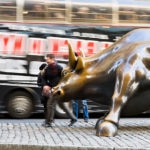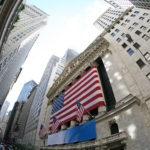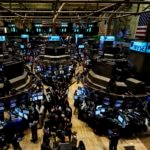History of investment banking (part 2)
The New Deal, the interventionist program Roosevelt promoted to soften the blow from the 1929 Wall Street Crash, meant that investment and retail banking must operate separately for the first time in history. After being separated in 1933, they began to develop independently during a period of economic boom in the U.S.

The post-war period brought unparalleled prosperity, underpinned by Keynesian policies, which lasted until the 1970s. But the end of the Cold War meant the early stages of globalization would begin. The idea of a world without barriers gained strength and it was an extraordinary period for mergers.
U.S. retail banks were aware that their margins were much lower than investment banks. The lack of regulation for investment banks allowed them to assume more and more risk.

New York Stock Exhachange's main door.
Deregulation begins
Given this scenario, activities that were previously prohibited under the Glass-Steagall Law began to be permitted. In 1988, many U.S. banks were already simultaneously acting like retail and investment banks, as the Federal Reserve had gradually made the financial system’s regulations more flexible.
But it was during the Democratic President Bill Clinton’s government, and the two subsequent decades of lax regulation by the Fed, when in 1999, the Gramm-Leach-Bliley Law repealed the Glass Steagall Law which enabled the creation of the country’s biggest conglomerates: Citigroup was established through the merger of Citicorp, a retail bank holding company, and the insurance company Travelers Group. The repeal of the law led to a period of “only the strongest will survive” and investment banking, in full swing at the time, prevailed.
The measures introduced in 1999 sought to put a stop to the financial system’s business model since the Great Depression. Retail banking and investment banking could now coexist.

U.S. economic prosperity in 2000.
A period of well-begin began that brought to mind the happy years of the 1920s. The outcome was also somewhat similar.
In 2000, Chase Manhattan, one of the largest retail banks in the U.S., acquired JP Morgan, one of the investment banking giants.
The U.S.’ Gramm-Leach-Bliley Law allowed banks to converge, but unlike Europe, in order for a retail bank to operate like an investment bank, it had to merge with an investment bank, and vice versa. So, in order to increase business, these mergers led to monstrous banks, which would later be known as “too big to fail”.
The rules of the game were changing and many in Wall Street thought the financial growth would never end.

Overview of the New York Stock Exchange trading floor. September 2008. - EFE
But the international financial system imploded in 2008, destroying banks’ sense of invulnerability. What started as an isolated liquidity problem in certain banks ended up collapsing a system based on speculation.
This is how one of the largest global economic recessions began, which drastically affected U.S. banks and spread to other sectors and banks around the world. “When the U.S. sneezes, the whole world catches a cold".
Investment banks collapse
The first investment bank to succumb to the financial crisis was Bear Stearns, which the U.S. Federal Reserve sold to J.P. Morgan. The next victim was Lehman Brothers. After 158 years in operation, it declared bankruptcy on September 15, 2008, severely impacted by toxic asset losses. At the same time, Bank of America acquired Merrill Lynch, an investment bank founded in 1914, making it one of the industry’s giants.

Lehman Brothers employee leaves the bank with the contents of his table in a box. - EFE
Goldman Sachs and Morgan Stanley were the last financial institutions affected by the financial crisis. Goldman Sachs took advantage of the Federal Reserve’s consent to stop acting as an investment bank and become a retail bank. J.P. Morgan, founded in 1935 as a result of the change in legislation after the financial crisis in 1929, was on the verge of bankruptcy in 2008, so the Federal Reserve informed the bank that it must stop acting as an investment bank and focus on retail banking.
This conversion allowed permanent access to more stable sources of financing and to the public assistance for the financial crisis, but it also implied greater control and regulation.
Turning back the clock
In response to the regulatory failures that became evident during the crisis, a profound change was legislated in the U.S. financial system which sought to prevent new financial crises. Following the advice of those who suggested going back to the past, including Nobel Laureate in Economics, Joseph Stiglitz, President Obama signed the Dodd-Frank Law in 2010, which once again separated the functions of retail and investment banks like in the Glass-Steagall law.
This reform involved a series of measures intended to limit the size of financial institutions. It also limited the operations banks can perform with customers’ money.

Barack Obama signs the Dodd-Frank Act, of Consumer Protection and Wall Street Reform with members of Congress, administration, Nancy Pelosi and Vice President Joe Biden in Washington.
The history of investment banking suggests that the industry was built on quicksand, with many regulatory changes based on the dominant economic school of thought at different periods of time. Today, rule of the financial system seems to go to those who most quickly adapt to customers’ needs.
Customers’ new habits are leading to a digital era in banking. As BBVA CEO Carlos Torres affirmed, the arrival of new players with superior value propositions and lower operating costs, like fintech firms, is threatening banks’ hegemony. It will be those who best adapt to this digital environment who will take the throne in the next financial scenario.